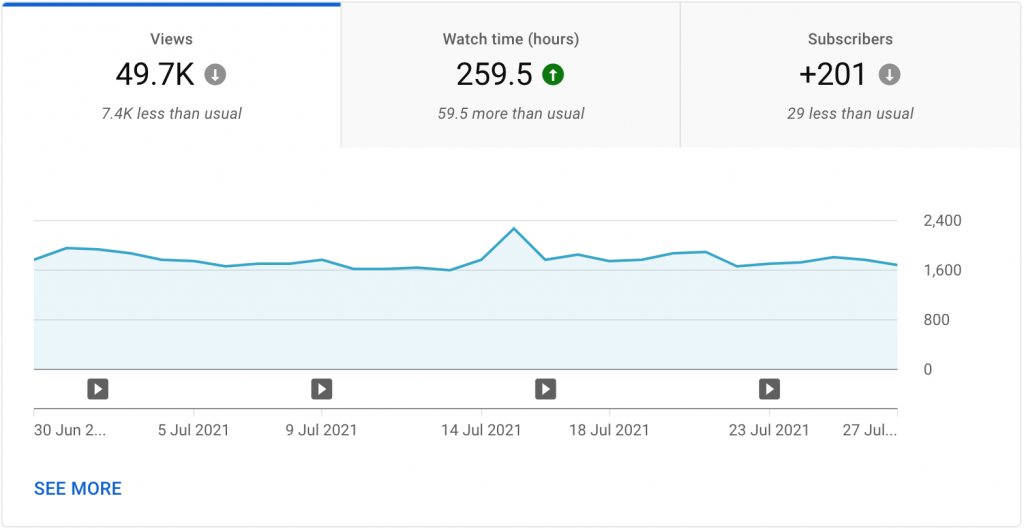Understanding YouTube Analytics | Grow Your Channel
If you’re looking to kickstart your vlogging career, then data is your friend. Here’s our guide to understanding YouTube analytics in order to grow your channel!
I’m thinking of getting a t-shirt with “YouTube is the second-largest site in the world” printed on it, since I say it so much. Anyway, it is. That means that there are videos covering just about anything you can think of on there. It’s also a video-sharing site that gets used by a number of types of people, for a variety of reasons. Someone might be on there for personal enjoyment, some might be utilising it as a marketing tool for their business, others might be shooting for that influencer lifestyle.
Whichever camp you find yourself in, the name of the game is always to grow your channel. This may be to boost engagement, sell a product or service, or share your creativity. Either way, increasing YouTube video views and gaining channel subscribers is generally the focus.
There are a plethora of ways to promote a channel on YouTube. Some examples are perfecting a scroll-stopping thumbnail, and utilising end screen cards. If you’re a numbers person, then using data should be an enjoyable way for you to grow your channel. If you aren’t a numbers person, understanding YouTube analytics doesn’t have to be scary. We’re going to break down what YouTube analytics is, which metrics you should be tracking, and how to use this information to your advantage.
Where to Find YouTube Analytics
Analytics is a set of data collected on your channel or website that shows you how your audience is interacting and engaging. It charts your performance and can help to identify trends, what works and what doesn’t. It is a huge aspect of digital marketing, and enables businesses and individuals to make informed and strategic decisions regarding growth and future campaigns.
That may have sounded quite formal and business-like, but you don’t have to be a marketing professional to understand analytics. All YouTube channels come with analytics for free. To find them, you simply need to sign in to YouTube Studio, then head to Analytics on the left. Here you’ll find an overview of your analytics, and tabs you can switch between for different data. There is also an advanced mode that will give you an expanded analytics report.
The Metrics That Matter

It can be tempting, when diving into the world of analytics, to try and track every metric available to you. However, trying to keep an eye on too much at once can be detrimental to your growth, and some metrics aren’t really as insightful as you might think. So, which metrics should you focus on?
Watch Time
YouTube has its own SEO, just like Google. One of the key things YouTube picks up on is the watch time of videos. The longer people watch a video, the higher it ranks on YouTube, thus getting more views.
In analytics, you can see the overall watch time of your videos, and also rank your videos by individual watch time. This enables you to see what viewers find engaging, so you know what you should create more of.
Average Veiw Duration
This is a number worked out by dividing your video’s watch time by the total number of video plays, including replays. Average view duration indicates how engaging your video is. If people aren’t getting drawn in by your content, they’ll exit the video, giving you a low average view duration.
Audience Retention
This is a fantastic metric for tracking exactly where your viewers are dropping off in a video. This is another indicator of just how engaging your video is. If you can retain the audience throughout the video, YouTube will reward you with a higer ranking.
This also helps you plan out future videos. Of course, you don’t want to become too formulaic, but you’ll have an idea of what video structure your audience enjoys best.
Impressions Click-Through Rate
The click-through rate (CTR) tells you how good your video is at prompting people to watch it after seeing it on the home page, in search results, or elsewhere. Impressions are how many times your video has appeared on the site and been viewed without being clicked on or opened.
Videos with a higher percentage CTR can inform you on how to present future videos to ensure people click on them. Things like an eye-catching thumbnail and a compelling title will help boost the CTR of a video.
Audience
If you don’t know who is actually watching your videos, then you will have no idea what content you should be creating. If you’re aiming content at American females aged 18-24, but are getting viewed by Brazilian males in their 40s, something needs to change. You can either try to cater to your existing South American audience, or change tack to try and target your desired audience.

Understanding YouTube analytics’ demographics report is key to figuring this out. It will also give you insights into when your audience is engaging with your content and whether they are subscribed to your channel or not. This can inform your posting schedule, and whether you need to focus on your CTA (call to action) game.
Engagement & Keywords
You can check out which search terms and keywords people are using that leads them to your content on YouTube. If you head to the Engagement tab and then to Adavanced Mode, you’ll be able to see the traffic sources of your viewers.
By selecting YouTube search as the traffic source, a list of the highest performing search terms will appear. From this, you can see exactly what your audience is looking for and are engaging with. For instance, if you first few results are “how to stream on Twitch”, “Twitch streaming help”, and “essential streaming gear for Twitch”, you can see that Twitch streaming content resonates well with your audience. However, try to avoid replicating high performing videos. Instead, think about how you can create a relevant video that is a little more niche and specific.
If you’re seeing a recurring keyword or search term that you don’t have a video relating, here is a huge opportunity for you to grab some viewers and boost your rankings.
Playlist Engagement
Organising your playlists in a way that highlights your best performing content can help boost views for the rest. Playlists are important in terms of ho your audience accesses a lot of your content. They make your videos highly binge-able and are great for keepping viewers on your channel for longer.
The playlist analytics shows you the views, average view duration, and average watch time of each playlist. If the numbers for a playlist are a little low, try putting a higher performing video at the start. Another good tip is to include relevant videos from other channels in your playlist. This can benefit your discoverability on YouTube as well as your retention.
Understanding & Using YouTube Analytics
That was a lot of information, so don’t panic if your brain is feeling a little full right now. By just beginning to look at and understand this YouTube analytics, you’ll be taking a big step towards growing your channel.
Using different areas of analytics can inform and help you to understand other areas. By focussing on the above listed key metrics, you should be able to gain a solid understanding of how your content performs, what your audience engages with, and how to attract new viewers.
Every successful YouTube channel features music in their videos. Fact. Give your videos a fighting chance at fame by joining Synchedin today!
Discover a huge library of awesome royalty free music, and subscribe to access unlimited downloads for just $4.99 per month. All tracks have the sync license covered, and come with full claims control, meaning no frustrating copyright issues down the line.
Sign up today to perfect your video content!
